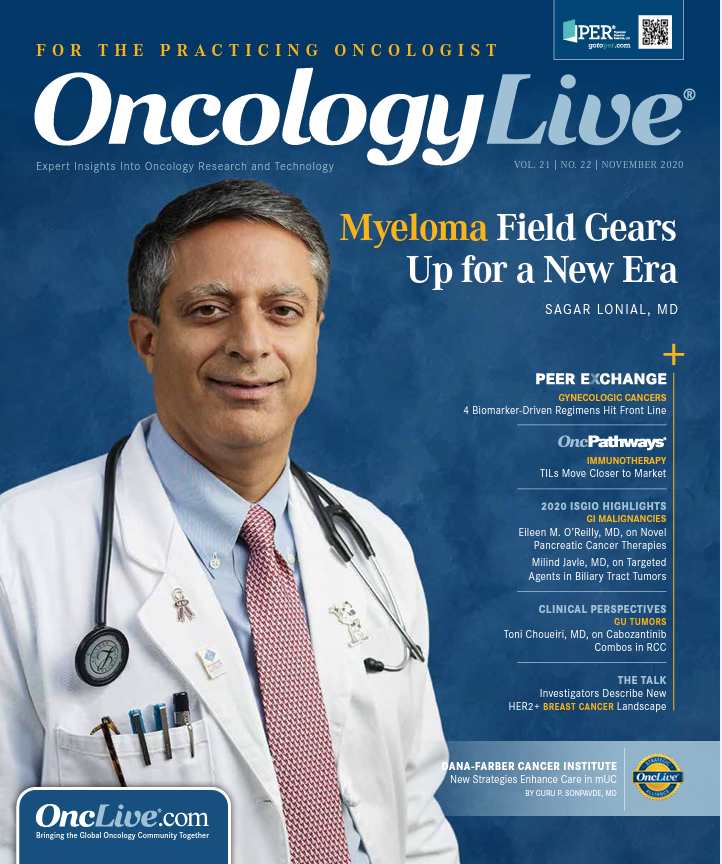Investigators Take Stock of New Landscape for Metastatic HER2-Positive Breast Cancer
Breast cancer specialists discuss noteworthy data on efficacy and safety about fam-trastuzumab deruxtecan-nxki, neratinib, and tucatinib.
Sara A. Hurvitz, MD

In the past year, 3 therapies have been introduced in the second and third line for patients with HER2-positive metastatic breast cancer. Although this represents a wealth of new options, experts say shaping treatment regimens for this patient population involves unpacking the nuances of clinical findings for these therapies and other available agents.
That was the goal of breast cancer specialists who participated in The Talk, an OncLive® video program, to discuss noteworthy data on efficacy and safety about fam-trastuzumab deruxtecan-nxki (Enhertu), neratinib (Nerlynx), and tucatinib (Tukysa) (Trial Snapshots1-6).
Trial Snapshots. Toxicity Profiles of HER2-Positive Metastatic Breast Cancer Agents1-6

Trastuzumab deruxtecan was the first of the new therapies to enter the treatment paradigm, with an FDA accelerated approval in December 2019 based on findings from the DESTINY-Breast01 trial (NCT03248492). The objective response rate in 184 patients was 60.3% (95% CI, 52.9%-67.4%), comprised of a 4.3% complete response rate and a 56.0% partial response rate. Further, the median response duration was 14.8 months (95% CI, 13.8-16.9).1
In February 2020, neratinib was approved in combination with capecitabine (Xeloda) based on data from the NALA trial (NCT01808573). The combination demonstrated median progression-free survival of 5.6 months (95% CI, 4.9-6.9) compared with 5.5 months (95% CI, 4.3-5.6) for patients treated with lapatinib (Tykerb) plus capecitabine, which translated to a hazard ratio of 0.76 (95% CI, 0.63-0.93; P = .0059). Median overall survival was 21 months and 18.7 months, respectively (HR, 0.88; 95% CI, 0.72- 1.07; P = .2086).2
Although the first 2 indications were for the third-line setting and beyond, the April 2020 approval of tucatinib in combination with trastuzumab (Herceptin) plus capecitabine was specified for patients who have received 1 or more prior anti–HER2-based regimens in the metastatic setting.3 Notably, this indication also includes patients with brain metastases, a population with a great unmet need. “Nearly 50% of patients with metastatic HER2-positive breast cancer will develop brain metastases,” said Sara A. Hurvitz, MD, who served as moderator of the program. “This is an area where we need more drugs like this.”
Hurvitz was joined by Aditya Bardia, MD, MPH; Claudine J. Isaacs, MD; and Sara M. Tolaney, MD, MPH, to review the latest data and ongoing investigations that can further carve out a role for these agents in a complex therapeutic landscape.
Aditya Bardia, MD, MPH

Trastuzumab Deruxtecan Offers Promise for Heavily Pretreated Patients
Hurvitz: For HER2-positive metastatic breast cancer, it’s been a real yawn lately, right? Only 3 FDA approvals in the past 7 months or so? It’s very exciting. We now have 7 FDA-approved drugs that target HER2 in the metastatic breast cancer setting.
Dr Bardia, if you could speak to the very exciting drug, trastuzumab deruxtecan. Can you tell us about the mechanism of action of this drug and the DESTINY Breast-01 results?
Bardia: Absolutely. Trastuzumab deruxtecan is a HER2-directed antibody-drug conjugate. It has several unique properties. The first is that it has a proprietary linker that allows for release of the drug potentially in the cancer cells. And also, this agent has a bystander effect, which allows the toxic payload to permeate outside of the cell membrane and affect the other cells in the microenvironment. The toxic payload with this agent is a topoisomerase 1 inhibitor, so it’s different from T-DM1 [ado-trastuzumab emtansine; Kadcyla], where the toxic payload is a [maytansine-derived toxin]. So in a number of ways, this drug is different than T-DM1 because of the bystander effect, as well as the toxic payload that it utilizes.
Investigators of DESTINY Breast-01 looked at the activity of trastuzumab deruxtecan in patients with metastatic HER2-positive breast cancer who were heavily pretreated. The median number of prior lines of therapy was 6. And [I have] never seen such an impressive waterfall plot. The data showed that the agent was incredibly active, with a very high response rate and deep responses in patients who were heavily pretreated.
The data were so compelling that the FDA provided accelerated approval to this agent for patients with metastatic disease. I think it’s an excellent option to have for our patients with metastatic disease. The challenge in the clinic is the sequencing of the various agents that we have and whether one should use 1 agent over the other.
Hurvitz: Yes, I agree. We don’t have data to guide our sequencing, and I think a lot of clinicians are using the presence or absence of brain metastases as sort of a litmus test of how to sequence tucatinib and trastuzumab deruxtecan. There are those who wonder whether we should be looking at trials to combine these 2 very active treatments. I think there are some [trials] that are being planned perhaps.
Dr Tolaney, can you take us through some of the important toxicities related to this therapy?
Tolaney: In general, from a day-to-day basis, most people tolerate the drug pretty well. They do get some GI [gastrointestinal] toxicity; patients can have some nausea, some very low-grade, mild loose stool. It actually does lower your neutrophil count. We can sometimes see some neutropenia as well. I should mention it can also cause alopecia, and it is something to discuss with your patients too.
A lot of attention was drawn to the risk of interstitial lung disease [ILD], and I think the reason this garnered some attention was the 4 deaths on the trial due to ILD. There was approximately a 13% rate of ILD overall.7 And actually, the majority of it was grade 1 and grade 2. But it is something I think we now are very cognizant of, given that it can be severe and can lead to complications.
ILD has been a challenge because I think what we’d want to know is: what are the risk factors for developing this and can we re-expose patients to the drug? So far, what we know from the data is that the risk factors for higher rates of ILD [appear to be] more heavily pretreated patients, patients of Asian descent, and those who received higher dosing of drug—higher than the FDA-approved dosing—when it was studied in phase 1.
And so I think we don’t yet have enough information about pulmonary function testing in these patients. Could we better predict who’s going to develop ILD if we had those tests at baseline to help us select patients? I think we’re going to learn more as time goes on. But for the time being, we have to be very cautious about this. So if a patient does develop, for example, asymptomatic ground-glass changes that [are seen] on CT, it is important to hold the drug and to monitor for resolution. And then if it resolves, the drug can be reintroduced with a dose reduction. But if the patient develops grade 2 ILD—they’re symptomatic— you do have to discontinue the drug and treat with steroids.
Given the outstanding efficacy from this drug with a progression-free survival of 16 months in someone with a median of 6 prior lines of therapy, I think we’re really eager to figure out which patients [with pulmonary toxicity] we could reinitiate the drug. I’m hoping we will learn more, but for now, those are the guidances.
Hurvitz: I think it becomes a little trickier in the COVID-19 [coronavirus disease 2019] era, where a patient can have cough and shortness of breath for an entirely nontoxicity-related reason. So all of us need to have this on our radar, certainly, when initiating any therapy that could cause a picture that mimics COVID-19.
Dr Isaacs, could you speak about the data relating to the use of trastuzumab deruxtecan for HER2 low–expressing cancers? What are we seeing?
Claudine J. Isaacs, MD

Isaacs: We have early encouraging data suggesting trastuzumab deruxtecan has activity beyond what we would think of as a traditionally HER2- positive disease. In patients with low HER2 expression, [immunohistochemistry] IHC1+ or IHC2+, the tumors are not amplified by FISH [fluorescence in situ hybridization].
There is an ongoing phase 3 trial [DESTINY Breast-04; NCT03734029] to address the activity of this drug. And as Dr Bardia mentioned, there is an interesting bystander effect and some of the questions around why it may have this activity are based on that bystander effect. I think practically speaking, it’s an incredibly important trial for us to accrue to. In the clinic today, we probably all have some patients who have these tumors that are heterogeneous, for which we’ve done biopsies at various times, with HER2-positive expression in some but HER2 low in others. These are the patients for whom I really think about using this drug with the thought that I would have activity or have the potential for activity in the different clones of the tumor.
Hurvitz: I agree. And I think it’s a very exciting drug. I’m looking forward to seeing these data as well as the data for patients with HER2 low expression, especially triple negative, with HER1- positive and HER2-positive disease. My hope is that we’ll have some efficacy there.
Tucatinib Targets CNS Metastases
Hurvitz: There are some very exciting data relating to tucatinib. Dr Isaacs, can you talk about the unique characteristics of this drug, the results of HER2CLIMB [NCT02614794], as well as some of the results relating to outcomes for patients with brain metastases reported at ASCO [2020 American Society of Clinical Oncology Virtual Scientific Program]?
Isaacs: Tucatinib is a tyrosine kinase inhibitor [TKI], and the HER2CLIMB randomized trial was really focused on, I think, a really relevant patient population. For quite a while we’ve known what to do in the first-line setting and the second-line setting, but then it was sort of a free-for-all as for what to do in the third-line setting in patients who had progressed following trastuzumab- or pertuzumab [Perjeta]-based therapy based on CLEOPATRA [NCT00567190] data or in the adjuvant or neoadjuvant setting and then after T-DM1.
What was really nice about the design of HER2CLIMB was that all patients had to have received all 3 of those drugs previously. The trial also allowed us to do something very practical, which is to allow patients with brain metastases who did not require immediate local therapy to go on a systemic therapy to see if we could control the CNS [central nervous system] disease. This was really based on trials that suggested activity for this drug and activity for some of the other TKIs in this setting, for neratinib, for instance.
Investigators also required a baseline MRI, which picked up some patients who had asymptomatic brain metastases. We know that is a problematic issue for our patients who often have HER2-positive disease and CNS involvement.
The trial design was for the treatment of patients with backbone therapy of either capecitabine/trastuzumab in a randomized placebo-controlled fashion with either tucatinib or with placebo. So the question was really, what does tucatinib add in this setting?
Results showed a statistically significant benefit in terms of progression-free survival. But perhaps most importantly, there was also a significant survival benefit of 4.5 to 5 months or so with the addition of the tucatinib.
The percentage of patients who had brain metastases at baseline was very high, just under half the patients. And when investigators looked at the analysis, they found that the drug also had activity in that subset of patients who had brain metastases. And just to give a number on that, progression-free survival was 25% at 1 year [with tucatinib] versus 0% for patients treated with placebo.
The presentation that Nancy U. Lin, MD, gave at ASCO focused on a related but separate question.8 And that was really specifically looking at the control in the CNS itself, not just control everywhere. CNS progression-free survival data for the patients who had brain metastases and brain metastases that were measurable showed a significant prolongation in CNS progression-free survival as well as an overall survival benefit. Further, [benefit was also seen] for patients who had brain metastases at presentation that were new, but the investigator felt that they did not require immediate local therapy.
I think what these data show us is that we have very active agents that can help control CNS disease. These are very exciting findings.
Hurvitz: Tucatinib’s HER2 selectivity makes it a very unique drug. Dr Tolaney, can you take us through the toxicity of tucatinib?
Sara M. Tolaney, MD, MPH

Tolaney: Tucatinib is a very potent TKI that is more focused against HER2 than some of the other TKIs. For example, neratinib is a pan-HER2 TKI, and lapatinib hits HER2 and HER1. The challenge with both lapatinib and neratinib has been the inhibition of EGFR, which has resulted in a lot of the toxicities that we’ve previously seen, such as rash or diarrhea. The advantage tucatinib has, from a toxicity profile, is that it is so selective against HER2 and really almost spares EGFR so that we are seeing much less in the way of GI toxicity.
Interestingly, tucatinib was given with capecitabine, which does cause diarrhea and PPE [palmar-plantar erythrodysesthesia]. Those rates were just slightly higher in the tucatinib arm compared with the capecitabine/trastuzumab arm. We also do see some elevation of liver function. We can see liver enzymes go up, and sometimes we see a random kind of blip in the bilirubin that can happen. It’s not common, but you can sometimes see that happen with tucatinib and then it will come down.
And so overall, I think it’s a pretty well-tolerated TKI compared with what we’re used to seeing with other TKIs.
Stacking the Deck in the Second Line and Beyond
Hurvitz: I think it was really interesting the FDA approved tucatinib in the second-line setting, so after patients had received a taxane and trastuzumab type of therapy. Are there any patients you would use this agent for in the second line?
Bardia: It’s clearly an active agent, and for me, this is attractive for 2 reasons. One is that it has activity in patients with brain metastases for whom traditionally, anti-HER2 therapies have not had so much activity. And second is the excellent safety. It gives patients an option to continue with a drug that is relatively well tolerated and good for brain metastases.
One thing that was pretty interesting in the HER2CLIMB trial was that patients who developed brain metastases during the study and then received local therapy were allowed to continue on. Those patients who received tucatinib had a further delay in the development of additional brain metastases. So this would be an agent that I would be very comfortable using in the second-line setting, particularly in a patient who has a known history of brain metastases.
Hurvitz: I would say that we’re all very focused on brain metastases because that’s a huge area of unmet need. The overall activity regardless of brain metastases was also pretty phenomenal.
On this niche topic of HER2-positive brain metastases, neratinib also had data relating to CNS outcomes from the NALA study.9 Neratinib has more toxicity due to the EGFR inhibition, but it is approved by the FDA in combination with capecitabine for HER2- positive metastatic breast cancer. Where do you see us using neratinib, if anywhere, in light of the very exciting tucatinib results?
Isaacs: I think that you’re asking a really important question, one that we’re grappling with as well. There certainly are data that neratinib has CNS activity. There are data from the NALA study and also from some of the TBCRC [Translational Breast Cancer Research Consortium] trials that have looked and shown activity in the CNS for this agent. There may be individual patients for whom we would think about using it.
We’re going to need to think about what’s next after tucatinib. And obviously, we have no data to tell us how these drugs will sequence with each other. But I think you’re raising a really important question. It is important to remember that we have options here, and there are going to be individual patients where we would choose one over the other.
References
- FDA approves fam-trastuzumab deruxtecan-nxki for unresectable or metastatic HER2-positive breast cancer. FDA. Updated December 20, 2019. Accessed October 25, 2020. https://www.fda.gov/drugs/resources-information-approved-drugs/fda-approves-fam-trastuzumab-deruxtecan-nxki-unresectable-or-metastatic-her2-positive-breast-cancer
- FDA approves neratinib for metastatic HER2-positive breast cancer. FDA. Updated February 26, 2020. Accessed October 25, 2020. https://www.fda.gov/drugs/resources-information-approved-drugs/fda-approves-neratinib-metastatic-her2-positive-breast-cancer
- FDA approves tucatinib for patients with HER2-positive metastatic breast cancer. FDA. Updated April 20, 2020. Accessed October 25, 2020. https://www.fda.gov/drugs/resources-information-approved-drugs/fda-approves-tucatinib-patients-her2-positive-metastatic-breast-cancer
- Ennhertu. Prescribing information. Daiichi Sankyo Company Ltd; 2019. Accessed October 26, 2020. https://www.accessdata.fda.gov/drugsatfda_docs/label/2019/761139s000lbl.pdf
- Nerlynx. Prescribing information. Puma Biotechnology Inc; 2020. Accessed October 26, 2020. https://www.accessdata.fda.gov/drugsatfda_docs/label/2020/208051s005s006lbl.pdf
- Tukysa. Prescribing information. Seattle Genetics Inc; 2020. Accessed October 26, 2020. https://www.accessdata.fda.gov/drugsatfda_docs/label/2020/213411s000lbl.pdf
- Modi S, Saura C, Yamashita T, et al; DESTINY-Breast01 Investigators. Trastuzumab deruxtecan in previously treated HER2-positive breast cancer. N Engl J Med. 2020;382(7):610-621. doi:10.1056/NEJMoa1914510
- Lin NU, Murthy RK, Anders CK, et al. Tucatinib versus placebo added to trastuzumab and capecitabine for patients with previously treated HER2+ metastatic breast cancer with brain metastases (HER2CLIMB). J Clin Oncol. 2020;38(suppl 15):1005. doi:10.1200/JCO.2020.38.15_suppl.1005
- Awada AH, Brufsky AM, Saura C, et al. Impact of neratinib on development and progression of central nervous system (CNS) metastases in patients with HER2-positive metastatic breast cancer (MBC): findings from the NALA, NEfERT-T, and TBCRC 022 trials. Cancer Res. 2020;80(suppl 4):P2-20-01. doi:10.1158/1538-7445.SABCS19-P2-20-01




